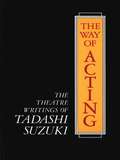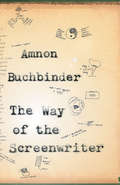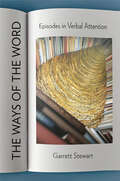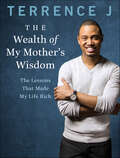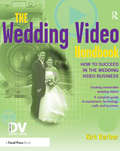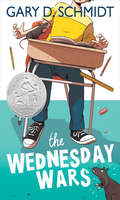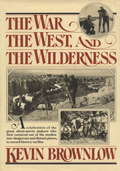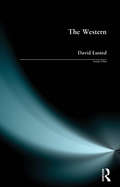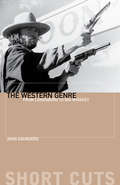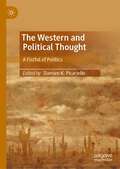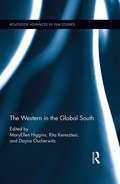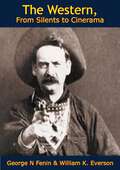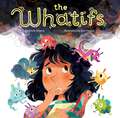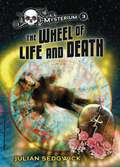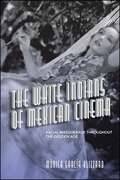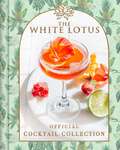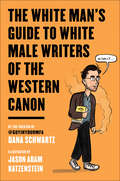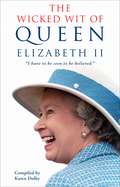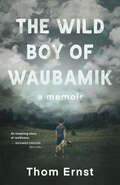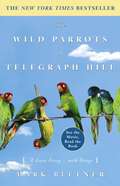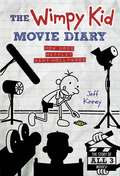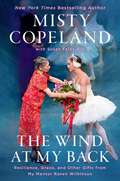- Table View
- List View
The Way of Acting
by J. Thomas Rimer Tadashi SuzukiThe most influential contemporary theatre director in Japan, Suzuki provides a thorough and accesible formulation of his ideas and beliefs, and insights into his training methods. Features his compelling adaptation of Clytemnestra--finding an astonishing parallel between ancient Greek and modern Japanese society, Suzuki melds traditional and avant-garde techinques to shed new light on this primal tale.
The Way of the Screenwriter
by Amnon BuchbinderA story is a living thing. And you don't work on a living thing, you work with it. This is the way of the screenwriter, and it is something that writer and director Amnon Buchbinder believes all masterful screenwriters understand intuitively: learning how to work with story through a painstaking process of trial, error, and self exploration. Amnon Buchbinder draws on his knowledge as a teacher and his experience as a script doctor and a story editor to explore this creative process. Along the way he illustrates principles often inspired by the philosophy of Laozi (Lao Tze) with examples drawn from major motion pictures such as Memento and The Piano. For the beginning or seasoned screenwriter who aspires to more than mere competence, Buchbinder illuminates a path towards mastery of the craft. For the lover of the cinematic experience, he opens a curtain to reveal a rarely seen world behind the big screen.
The Ways of the Word: Episodes in Verbal Attention
by Garrett StewartIn The Ways of the Word, Garrett Stewart steps aside from theory to focus on the sheer pleasure of attentive reading and the excitement of recognizing the play of syllables and words upon which the best literary writing is founded. Emerging out of teaching creative writing and a broader effort to convene writers and critics, Stewart's "episodes in verbal attention" track the means to meaning through the byways of literary wording.Through close engagement with literary passages and poetic instances whose imaginative demands are their own reward, Stewart gathers exhibits from dozens of authors: from Dickinson, Dickens, and DeLillo to Whitman, Woolf, and Colson Whitehead. In the process, idiom, tense, etymology, and other elements of expressive language and its phonetic wordplay are estranged and heard anew. The Ways of the Word fluidly and intuitively reveals a verbal alchemy that is as riveting as it is elusive and mysterious.
The Wealth of My Mother's Wisdom: The Lessons That Made My Life Rich
by Terrence J.In this uplifting memoir, “the amiable on-screen personality and actor reveals the source of his good fortune: his tender and tenacious mother” (Essence).When Lisa Gonzalez, a seventeen-year-old from Queens, New York, found out she was pregnant, she knew she only had one choice—to keep the child and give him the best life she could. That baby was Terrence Jenkins, better known to the world as Terrence J. From hosting gigs on BET's 106 and Park and E! News to roles in some of Hollywood's biggest movies, Terrence J is living a life he could have only imagined when he was a young boy. But it was the lessons he learned from his mother that helped make him a man—lessons about sacrifice, courage, loyalty, dreams, and perseverance. Through her words and her actions, Lisa showed Terrence the right path.From an early age Terrence's mother pushed him to succeed and led by example. Most important, she put her son first—even if it meant leaving behind the only life she had ever known in New York City in search of a safer environment for her son, having the drive to go back to school to learn a new skill, or having the courage to start her own business and build it from the ground up. Her drive eventually became Terrence's drive.Inspirational, funny, and down-to-earth, The Wealth of My Mother's Wisdom offers stories, lessons, and advice from one of the top young names in Hollywood, along with input from some of his famous friends like Kevin Hart, Ludacris, T.I., Trey Songz, and Laz Alonso. Terrence J offers a positive, powerful message: with a strong family bond, the possibilities are endless.
The Wedding Video Handbook: How to Succeed in the Wedding Video Business
by Kirk BarberFor readers who want to become part of the thriving wedding video industry, Wedding Video Handbook explains everything a wedding videographer needs to know. Each chapter explores a different part of either the business or the production ends, and covers topics including secrets for getting clients, selecting the proper equipment, and tips on capturing special wedding moments despite difficult filming conditions. The book includes handy primers on marketing and advertising, handling phone calls and appointments, pre-production preparations, what to shoot on the wedding day, interacting with other vendors, editing and packaging the DVD or video, and generating referrals. Fully up-to-date with information on the newest tools and equipment used in this rapidly-evolving market as well as the cutting-edge trends in wedding video products, Wedding Video Handbook is packed with practical advice from a pro who has spent years in the field.
The Wednesday Wars
by Gary D. SchmidtIn this Newbery Honor-winning novel, Gary D. Schmidt offers an unforgettable antihero. The Wednesday Wars is a wonderfully witty and compelling story about a teenage boy’s mishaps and adventures over the course of the 1967–68 school year in Long Island, New York.<P><P> Meet Holling Hoodhood, a seventh-grader at Camillo Junior High, who must spend Wednesday afternoons with his teacher, Mrs. Baker, while the rest of the class has religious instruction. Mrs. Baker doesn’t like Holling—he’s sure of it. Why else would she make him read the plays of William Shakespeare outside class? But everyone has bigger things to worry about, like Vietnam. His father wants Holling and his sister to be on their best behavior: the success of his business depends on it. But how can Holling stay out of trouble when he has so much to contend with? A bully demanding cream puffs; angry rats; and a baseball hero signing autographs the very same night Holling has to appear in a play in yellow tights! As fate sneaks up on him again and again, Holling finds Motivation—the Big M—in the most unexpected places and musters up the courage to embrace his destiny, in spite of himself.
The Weekend: An unforgettable story of female friendship by the bestselling author of the Booker Prize-shortlisted Stone Yard Devotional
by Charlotte Wood'So great I am struggling to find the words to do it justice' Marian KeyesA Book of the Year for The Times, Observer, Independent and Good Housekeeping'A rare pleasure' Sunday Times'Riveting' Elizabeth Day'A perfect, funny, insightful, novel about women, friendship, and ageing' Nina Stibbe'A lovely, lively, intelligent, funny book' Tessa Hadley'Glorious . . . Charlotte Wood joins the ranks of writers such as Nora Ephron, Penelope Lively and Elizabeth Strout' GuardianSylvie, Jude, Wendy and Adele have been friends for decades, but when Sylvie dies, the ground shifts dangerously for the remaining three.These women couldn't be more different: Jude, a once-famous restaurateur with a long-standing affair with a married man; Wendy, an acclaimed feminist intellectual; Adele, a former star of the stage, now practically homeless. Struggling to recall exactly why they've remained close all these years, the grieving women gather for one last weekend at Sylvie's old beach house. But fraying tempers, an elderly dog, unwelcome guests and too much wine collide in a storm that threatens to sweep away their friendship for good.
The Wendy Williams Experience
by Wendy WilliamsIn the dishiest book of the year, the top-rated and controversial radio host delivers the good, the bad, and the ugly on the industry's biggest stars. But we'll let her speak for herself: Whitney Houston: "We have watched her go from our princess...to what looks like one step above a crackhead."
The West Wing (TV Milestones)
by Janet MccabeWith its fast and furious dialogue, crackling wit, and political savvy, The West Wing became appointment TV for millions during its seven-season run between 1999 and 2006. The behind-the-scenes ensemble drama about Washington politics premiered on the wake of the Monica Lewinsky scandal, was the first series to respond to the 9/11 terrorist attacks, and concluded in the closing years of the Bush administration. Its subject matter was ambitious and germane, its cast star-studded, its production team acclaimed. In this volume, Janet McCabe explores The West Wing as both a space for political and social discourse and a force that reshaped contemporary television. McCabe begins by examining the series' broadcasting history, including its scheduling in the United States and around the world, and how the show defines channels and television markets. McCabe goes on to explore the role of the show's creator Aaron Sorkin as a TV auteur and investigates the program's aesthetic principles, including the distinctive look, feel, and sounds of the series. McCabe concludes by considering the political discourse of The West Wing, as the show spoke back to a U.S. culture divided by politics, race, and gender as well as the trauma of 9/11 and anxieties over terrorism and the wars in Iraq and Afghanistan. McCabe's analysis of The West Wing provides an intriguing look at the institutional, formal, and cultural politics of television. Fans of the series as well as students and teachers of television history will enjoy this detailed volume.
The West, The War, and The Wilderness
by Kevin BrownlowHere, from one of today's leading authorities on film history, is the story, told brilliantly and for the first time, of the pioneering movie makers who as early as 1905 traveled beyond the studio stages to make feature films on location--and in so doing recorded the real history and real life of their time. The War, the West, and the Wilderness is the result of more than a decade of passionate research by Kevin Brownlow, whose last book, The Parade's Gone By... (hailed by Charles Champlin as "the definitive work on the silent era") is regarded as a classic history of early motion pictures. His new book is alive with the voices of the film-makers themselves, in their logbooks, in their letters and diaries, in their firsthand accounts of their adventurous journeys and cinematic innovations, and--even more immediate--in Brownlow's interviews with cameramen, director's, lighting technicians, and actors who relive those days, taking us with them to the Great War, to the West, ad into the Wilderness. It is the triumph of this book to reconstruct the dramatic moments when these men and women contrived, against ordinary odds, to bring to movie audiences for the first time, the look, the feel--the actuality--of large events and distant places, from the great battles of World War I to the South Seas with Jack London aboard the Shark, and the gold rush in Tonopah, Nevada.
The Western (Inside Film)
by David LustedThe Western introduces the novice to the pleasures and the meanings of the Western film, shares the excitement of the genre with the fan, addresses the suspicions of the cynic and develops the knowledge of the student. The Western is about the changing times of the Western, and about how it has been understood in film criticism. Until the 1980s, more Westerns were made than any other type of film. For fifty of those years, the genre was central to Hollywood's popularity and profitability. The Western explores the reasons for its success and its latter-day decline among film-makers and audiences alike. Part I charts the history of the Western film and its role in film studies. Part II traces the origins of the Western in nineteenth-century America, and in its literary, theatrical and visual imagining. This sets the scene to explore the many evolving forms in successive chapters on early silent Westerns, the series Western, the epic, the romance, the dystopian, the elegiac and, finally, the revisionist Western. The Western concludes with an extensive bibliography, filmography and select further reading. Over 200 Westerns are discussed, among them close accounts of classics such as Duel in the Sun, The Wild Bunch and Unforgiven, formative titles like John Ford's epic The Iron Horse, and early cowboy star William S. Hart's The Silent One together with less familiar titles that deserve wider recognition, including Comanche Station, Pursued and Ulzana's Raid.
The Western Genre: From Lordsburg to Big Whiskey (Short Cuts)
by John SaundersThe Western Genre: From Lordsburg to Big Whiskey offers close readings of the definitive American film movement as represented by such leading exponents as John Ford, Howard Hawks, and Sam Peckinpah. In his consideration of such iconic motifs as the Outlaw Hero and the Lone Rider, John Saunders traces the development of perennial aspects of the genre, its continuity and, importantly, its change. Representations of morality and masculinity are also foregrounded in consideration of the genre's major stars John Wayne and Clint Eastwood, and such films as Shane, Rio Bravo, The Wild Bunch, and Unforgiven.
The Western and Political Thought: A Fistful of Politics
by Damien K. PicarielloThe Western and Political Thought: A Fistful of Politics offers a variety of engaging and entertaining answers to the question: What do Westerns have to do with politics? This collection features contributions from scholars in a variety of fields—political science, English, communication studies, and others—that explore the connections between Westerns (prose fiction, films, television series, and more) and politics.
The Western in the Global South (Routledge Advances in Film Studies)
by MaryEllen Higgins Rita Keresztesi Dayna OscherwitzThe Western in the Global South investigates the Western film genre's impact, migrations, and reconfigurations in the Global South. Contributors explore how cosmopolitan directors have engaged with, appropriated, and subverted the tropes and conventions of Hollywood and Italian Westerns, and how Global South Westerns and Post-Westerns in particular address the inequities brought about by postcolonial patriarchy, globalization and neoliberalism. The book offers a wide range of historical engagements with the genre, from African, Caribbean, South and Southeast Asian, Central and South American, and transnational directors. The contributors employ interdisciplinary cultural studies approaches to cinema, integrating aesthetic considerations with historical, political, and gender studies readings of the international appropriations and U.S. re-appropriations of the Western genre.
The Western: From Silents to Cinerama
by George N Fenin William K. EversonGround-breaking and essential history of the genre, highlighted by superb research, penetrating insights, and sharp, entertaining prose. Smartly designed, with scads of rare b&w photos laid out in a dynamic and witty design.-Print ed.“For many years the Western film has been strangely and unfairly neglected. Although many articles and essays have appeared in general and specialized periodicals all over the world, substantially organic books dealing exclusively with the Western are very rare indeed. And of all this material, the majority has been disguised publicity, or at best essays which refused to take the Western seriously, the work of writers who knew little or nothing of Westerns, writers who glibly referred to the cliché of the hero always kissing his horse instead of the girl, leaving it at that….We felt, therefore, that there was not only room, but a need, for a detailed history of the Western, a book which would represent not only a useful study of the industrial and aesthetic growth of a popular movie genre, but a critical analysis of it, as well. For the most part, we have adopted a strictly chronological approach, but, in the parlance of the film, it has sometimes been necessary to use “flash-forwards and cutbacks” and even a form of montage, in order to follow a thesis through to its logical conclusion.”-Introduction.
The Whatifs
by Emily Kilgore"Persico's atmospheric illustrations aptly reflect Cora's shifting emotions, and Kilgore successfully balances the whimsical with a tale grounded in reality." -Publishers Weekly"Cora and her Whatifs have a charming appeal beyond their focus on tackling anxious thoughts, making an enjoyable read-aloud for wide audiences. . . . A thoroughly welcome addition to growing collections of socio-emotional development materials." -Kirkus ReviewsCora is struggling with her Whatif questions ahead of a big piano recital in this timely picture book about overcoming anxiety.What if my dog runs away?What if I forget my homework?What if the sun stops shining?What if my crayon breaks?Cora is constantly worrying about everything. Because of this, the Whatifs love her. They sneak up to her and give her all kinds of doubts: big or small, silly or frightening, likely or impossible. As she prepares for an upcoming piano recital, the Whatifs cling on tighter and drag her down, making her anxious about messing up during the concert. Will she be able to change her worry-filled thoughts into hopeful ones?
The Wheel of Life and Death (Mysterium #3)
by Julian SedgwickAfter a close call with an assassin in Barcelona, Danny is more convinced than ever that his parents—star performers in the Mysterium circus—died under suspicious circumstances. He's also sure that there's a traitor within the Mysterium. As the troupe heads to Berlin for a circus festival, Danny scrambles to unravel the clues his father left behind. He'll need his decoding skills—plus some extremely risky circus tricks—to find out what really happened to his parents and who's still trying to sabotage the Mysterium. Can he expose his parents' killer before disaster strikes again?
The White Indians of Mexican Cinema: Racial Masquerade throughout the Golden Age (SUNY series in Latin American Cinema)
by Mónica García BlizzardThe White Indians of Mexican Cinema theorizes the development of a unique form of racial masquerade—the representation of Whiteness as Indigeneity—during the Golden Age of Mexican cinema, from the 1930s to the 1950s. Adopting a broad decolonial perspective while remaining grounded in the history of local racial categories, Mónica García Blizzard argues that this trope works to reconcile two divergent discourses about race in postrevolutionary Mexico: the government-sponsored celebration of Indigeneity and mestizaje (or the process of interracial and intercultural mixing), on the one hand, and the idealization of Whiteness, on the other. Close readings of twenty films and primary source material illustrate how Mexican cinema has mediated race, especially in relation to gender, in ways that project national specificity, but also reproduce racist tendencies with respect to beauty, desire, and protagonism that survive to this day. This sweeping survey illuminates how Golden Age films produced diverse, even contradictory messages about the place of Indigeneity in the national culture.This book is freely available in an open access edition thanks to TOME (Toward an Open Monograph Ecosystem)—a collaboration of the Association of American Universities, the Association of University Presses, and the Association of Research Libraries—and the generous support of Emory University and the Andrew W. Mellon Foundation. Learn more at the TOME website, available at: https://www.openmonographs.org/. It can also be found in the SUNY Open Access Repository at http://hdl.handle.net/20.500.12648/7153
The White Lotus Official Cocktail Collection: Sunset in Paradise
by Sarah Gualtieri Emma Carlson BerneFrom the critically acclaimed hit television show on HBO, comes a cocktail book designed to bring the elegant resort experience to your home. With 60 cocktails to take you from Hawaii to Sicily to Thailand, an exotic escape awaits you in every glass.With fifteen Emmy Awards won for Seasons 1 and 2, and high anticipation for Season 3, The White Lotus has successfully captured the essence of luxury and exotic allure through a world of opulent fashion, sophisticated design, and tantalizing flavors. In this official cocktail guide, savor the sophistication and elegance with each drink filled with a hint of tropical paradise and fantasy. Sunset in Paradise promises more than just refreshment – it's a vacation in every glass. From the delicate floral notes of the Jasmine Lychee Martini while relaxing poolside to the serenity of the Basil Oasis while watching the sun set, each cocktail is an invitation to escape. Picture yourself sunning out on the veranda with a Butterfly Lemonade or reviving after a dip with the invigorating Mango Sunrise. Brunch with friends becomes an exquisite affair with the Pineapple Sunset Mimosa, while a sun-drenched lunch is a thirst-quenching delight with the mocktail, Coconut Refresher. The choice is yours as you craft each cocktail with The White Lotus flair. Expect only the best while elevating your cocktail game with The White Lotus Official Cocktail Collection: Sunset in Paradise, where every sip is a lavish voyage into the extraordinary.
The White Man's Guide to White Male Writers of the Western Canon
by Dana Schwartz Jason Adam KatzensteinThe White Man's Guide to White Male Writers of the Western Canon is a hilarious exploration of the literary world from Dana Schwartz, aka @GuyInYour MFA.Illustrations by Jason Adam KatzensteinHow do you use ‘taraddidle’ in a sentence? Is it possible to make a Gin Ricky that’s also a metaphor for the American Dream? How can you tell your Faulkner from your Franzen if you haven’t actually read either?Allow me, the @GuyInYourMFA, to expound on the most important (aka white male) writers of western literature. You’ve probably seen me around, observing the masses, or defying the wind by hand-rolling a cigarette outside a local, fair-trade coffee shop. I’ve actually read Infinite Jest nine and a half times. Care to discuss?From Shakespeare's greatest mystery (how could a working-class man without access to an MFA program be so prolific?) to the true meaning of Kafkaesque (you know you've made it when you have an adjective named for you), the pages herewith are at once profound and practical. Use my ingenious Venn diagram to test your knowledge of which Jonathan—Franzen, Lethem, or Safran Foer—hates Twitter and lives in Brooklyn. (Trick question: all three!) Sneer at chick-lit and drink Mojitos like Hemingway (not like middle-aged divorcées!).So instead of politely nodding along next time you make an acquaintance at a housewarming party in Brooklyn, you can roll up your sleeves and get to work schooling them in character arcs and the experimental form of your next great American novel. Dazzle your friends with how well you understand post-modernism. You’ll be at a literary event asking a question “that’s really more of a comment” in no time.
The Wicked Wit of Queen Elizabeth II
by Karen DolbyA charming collection of quotes and anecdotes celebrating the incomparable Queen of EnglandWhen we think of the queen, we probably picture a serious, dignified personage complete with majestic hat and matching handbag. But The Wicked Wit of Queen Elizabeth II reveals a side of the monarch the public rarely sees, her healthy sense of humor: sometimes silly, sometimes sarcastic—and occasionally unintentional (to guitar legend Eric Clapton: “Have you been playing long?”)!This is a delightful celebration of the queen’s humor revealed through her own words on topics from family and travel to pets and hobbies, as well as stories from the royal household of Britain’s longest-serving monarch. In addition to the queen, other royals get in their two cents, including the famously filterless Prince Philip and the acerbic Princess Margaret, as well as Prince Charles and Princess Anne.
The Wild Boy of Waubamik: A Memoir
by Thom Ernst“An inspiring story of resilience, told with a vivid sense of character and humour.” —RICHARD CROUSE, CTV host and film criticFilm critic, writer, and broadcaster Thom Ernst chronicles his life growing up with an abusive father in rural Ontario.The residents of Waubamik know about the Wild Boy, a somewhat feral child, standing nearly naked in a rusty playground of weeds and discarded metal, clutching a headless doll. They know the boy has been plucked from poverty and resettled into a middle-class family. But they don’t know that something worse awaits him there.This is the story of a system that failed, a community that looked the other way, and a family that kept silent. It is also a record of the popular culture of the 1960s — a powerful set of myths that kept a boy comforted. But ultimately, The Wild Boy of Waubamik is a story of triumph, of a man who grew up to become a film critic and broadcaster despite his abusive childhood. It reminds us that life, even at its darkest, can surprise us with moments of joy and hope and dreams for the future.
The Wild Parrots of Telegraph Hill: A Love Story ... with Wings
by Mark BittnerTrue story of the flock of wild parrots who live in San Francisco's Telegraph Hill, and the man who became a local expert on them. When Judith Irving made a documentary about Mark and the parrots, his life took a surprising turn.
The Wimpy Kid Movie Diary (Dog Days Revised and Expanded Edition)
by Jeff KinneyIf you’ve ever wondered how a movie gets made, you’re not alone. Author and illustrator Jeff Kinney didn’t know either, but when his bestselling Diary of a Wimpy Kid series was turned into a live-action movie by 20th Century Fox, he learned how books get adapted for the screen in not one but three major motion pictures. Complete with photographs, script pages, storyboard sketches, costume designs, and original art by Jeff Kinney, The Wimpy Kid Movie Diary—now updated to include the new movie Diary of a Wimpy: Dog Days—is the perfect companion to the bestselling series.
The Wind at My Back: Resilience, Grace, and Other Gifts from My Mentor, Raven Wilkinson
by Misty CopelandFrom celebrated ballerina and New York Times bestselling author Misty Copeland, a heartfelt memoir about her friendship with trailblazer Raven Wilkinson which captures the importance of mentorship, shared history, and honoring the past to ensure a stronger future.Misty Copeland made history as the first African-American principal ballerina at the American Ballet Theatre. Her talent, passion, and perseverance enabled her to make strides no one had accomplished before. But as she will tell you, achievement never happens in a void. Behind her, supporting her rise was her mentor Raven Wilkinson. Raven had been virtually alone in her quest to breach the all-white ballet world when she fought to be taken seriously as a Black ballerina in the 1950s and 60s. A trailblazer in the world of ballet decades before Misty&’s time, Raven faced overt and casual racism, hostile crowds, and death threats for having the audacity to dance ballet.The Wind at My Back tells the story of two unapologetically Black ballerinas, their friendship, and how they changed each other—and the dance world—forever. Misty Copeland shares her own struggles with racism and exclusion in her pursuit of this dream career and honors the women like Raven who paved the way for her but whose contributions have gone unheralded. She celebrates the connection she made with her mentor, the only teacher who could truly understand the obstacles she faced, beyond the technical or artistic demands.A beautiful and wise memoir of intergenerational friendship and the impressive journeys of two remarkable women, The Wind at My Back captures the importance of mentorship, of shared history, and of respecting the past to ensure a stronger future.
